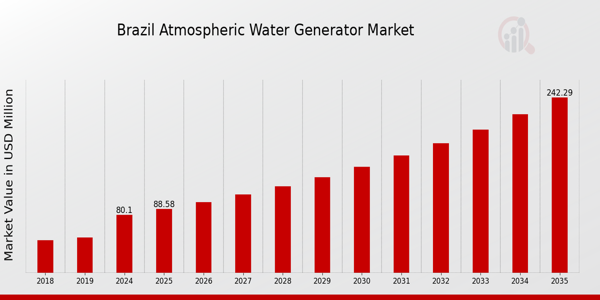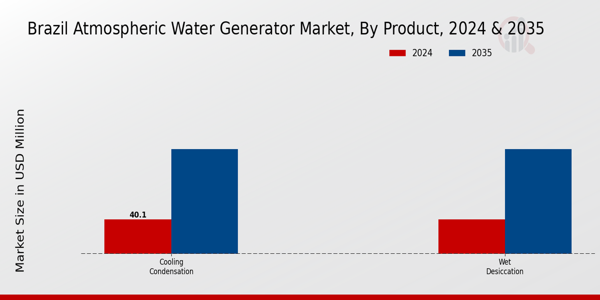Brazil Atmospheric Water Generator Market Overview
The Brazil Atmospheric Water Generator Market Size was estimated at 74.1 (USD Million) in 2023. The Brazil Atmospheric Water Generator Market Industry is expected to grow from 80.1(USD Million) in 2024 to 242.3 (USD Million) by 2035. The Brazil Atmospheric Water Generator Market CAGR (growth rate) is expected to be around 10.586% during the forecast period (2025 - 2035).
Key Brazil Atmospheric Water Generator Market Trends Highlighted
Several important market forces driving demand for Atmospheric Water Generators (AWGs) in Brazil include growing worries about water shortages and the need for sustainable water solutions. Especially in areas like the Northeast, where drought conditions are common, the Brazilian government has acknowledged water management as a vital concern. Government recognition helps to create a favourable climate for innovations offering substitute water sources.
Consumer knowledge of health and wellbeing is also increasing interest in clean and safe drinking water, which helps to promote AWGs as feasible solutions that can directly tackle these health issues. Recent developments in Brazil draw attention to the movement in the water-generating industry toward environmentally friendly and energy-efficient solutions. Manufacturers are concentrating on creating AWGs that not only draw water from the air but also reduce energy use.
Cooperation between local tech companies and foreign inventors is developing to allow the use of innovative technologies suited to local environmental circumstances. Local projects meant to encourage sustainable behaviours and natural resource protection help to promote this trend even further. Especially in cities where water shortage is obvious, chances are arising for companies in the Brazil Atmospheric Water Generator Market.
Building alliances with commercial enterprises and residential complexes would help increase market penetration. The inclusion of AWGs into public infrastructure, such as schools and community centres, represents another hopeful prospect as Brazil struggles with climate change. In the end, Brazil's mix of encouraging regulations, rising public knowledge, and technical developments create a good picture for the expansion of the Atmospheric Water Generator industry in the area.

Source: Primary Research, Secondary Research, Market Research Future Database and Analyst Review
Brazil Atmospheric Water Generator Market Drivers
Increasing Water Scarcity in Brazil
Brazil is experiencing escalating water scarcity due to climate change, growing population, and urbanization. Data from the National Water Agency indicates that approximately 25 million people in Brazil face a lack of access to safe drinking water. With severe droughts occurring more frequently, the demand for innovative solutions to source clean water is surging.
The Brazilian Atmospheric Water Generator Market Industry is positioned to address this urgent need by providing systems that generate water from humidity in the air, significantly contributing to tackling the water crisis in regions like Northeast Brazil. Companies such as Watergen and Zero Mass Water have recognized this issue and are actively developing their innovative Atmospheric Water Generators to tap into Brazil's vast humidity levels, fostering growth in this market.
Government Initiatives Promoting Water Conservation
The Brazilian government's commitment to water conservation is evident through policies aimed at improving water management and accessibility. The Federal Government and regional authorities have launched initiatives to promote sustainable practices and enhance the availability of potable water. Considering that the Brazilian Water Law prioritizes the efficient use of water resources, this framework encourages the installation of technologies like Atmospheric Water Generators.
As organizations, local councils, and NGOs implement projects to integrate these technologies into communities, the momentum for the Brazil Atmospheric Water Generator Market Industry is increasing, leading to broader acceptance and implementation.
Emergence of Sustainable Water Solutions
The global shift towards sustainability has influenced Brazilian industries, with an increasing number of stakeholders emphasizing eco-friendly solutions. Surveys from the Brazilian Institute of Geography and Statistics indicate that 60% of Brazilians are inclined towards using environmentally sustainable products. The demand for Atmospheric Water Generators, which utilize renewable energy sources to produce clean water, aligns perfectly with this trend.
Companies like Source Global are entering the Brazil Atmospheric Water Generator Market Industry, catering to this growing consumer preference for sustainable water solutions. As awareness of eco-sustainable practices increases, this market is expected to experience accelerated growth.
Technological Advancements in Atmospheric Water Generation
Recent advancements in technology have significantly improved the efficiency and cost-effectiveness of Atmospheric Water Generators. Research and Development (R&D) investments in this field have led to innovations that allow for higher water extraction rates from air, making the units more appealing to consumers and businesses alike. Brazilian startups and established companies, such as Aqualuz and Evapolar, are pioneering these advancements, leading to lower operational costs and increased effectiveness of their products.
The growing trend toward adopting smart, energy-efficient systems is bolstering the Brazil Atmospheric Water Generator Market Industry, as more users seek reliable solutions to mitigate water scarcity efficiently.
Brazil Atmospheric Water Generator Market Segment Insights
Atmospheric Water Generator Market Product Insights
The Brazil Atmospheric Water Generator Market exhibits considerable potential, driven primarily by the growing demand for efficient water purification systems amidst ongoing water scarcity issues. In recent years, the importance of sustainable water solutions has intensified, paving the way for Atmospheric Water Generators. Within this market, the product segment showcases significant diversity, particularly through two notable technologies Cooling Condensation and Wet Desiccation.
Cooling Condensation typically features systems that cool the air, causing humidity to condense into liquid water, making it an effective solution for regions with high humidity levels, including many areas within Brazil. This method boasts a high efficiency in water generation and is gaining traction due to its relatively straightforward technology and operational cost-effectiveness.
On the other hand, Wet Desiccation represents another innovative technology, leveraging desiccant materials to extract moisture from the air. This method is particularly advantageous in arid environments or regions with low humidity, providing a reliable alternative to traditional water sourcing. Brazil’s climatic diversity supports the implementation of both technologies, enabling operators to select the most appropriate system based on geographical and climatic conditions.
As urbanization continues to rise and concerns regarding water quality and availability become more pronounced, it is anticipated that the demand for these technologies will increase. Market players are focusing on improving product efficiency and expanding application areas, contributing to the overall momentum of the Brazil Atmospheric Water Generator Market.
The distinctions between Cooling Condensation and Wet Desiccation are crucial for users, as these technologies cater to different environmental requirements while addressing the common goal of producing potable water sustainably. Consequently, both technologies play a pivotal role in the advancement of water generation solutions, reflecting a broader trend towards innovative approaches in water scarcity management within Brazil.

Source: Primary Research, Secondary Research, Market Research Future Database and Analyst Review
Atmospheric Water Generator Market Application Insights
The Brazil Atmospheric Water Generator Market is experiencing growth across various applications, prominently within the Industrial, Commercial, and Residential sectors. The increasing need for sustainable and clean water solutions in Brazil drives market dynamics, as the country faces challenges related to water scarcity in certain regions. In the industrial segment, companies are increasingly adopting atmospheric water generators as a reliable source of water for manufacturing processes, positively impacting operational efficiencies.
The commercial sector is witnessing a significant rise in demand for these generators in office buildings, hotels, and restaurants, which strive to enhance their sustainability efforts and provide high-quality water to customers. Meanwhile, the residential segment is gaining traction, with homeowners seeking alternatives to bottled water to reduce plastic waste and ensure constant access to potable water.
Overall, the Brazil Atmospheric Water Generator Market segmentation reflects a strong inclination towards innovative solutions that address pressing water-related issues while supporting environmental sustainability initiatives. Market trends point towards an increased focus on technological advancements and partnerships, enhancing the appeal of atmospheric water generators across diverse applications in Brazil.
Brazil Atmospheric Water Generator Market Key Players and Competitive Insights
The Brazil Atmospheric Water Generator Market is witnessing a period of significant growth and innovation, driven by various factors including the increasing demand for sustainable water sources and growing awareness of water scarcity issues. As environmental concerns rise, more companies are entering the market with effective solutions aimed at tapping into the atmospheric moisture to produce potable water. This niche market is becoming increasingly competitive as players seek to differentiate their offerings through technological advancements and improved efficiency.
The competitive landscape comprises a mix of established manufacturers and emerging startups, all vying for market share in a rapidly evolving sector. Companies are leveraging strategic partnerships, regulatory support, and investment in research and development to enhance their market presence and appeal to environmentally conscious consumers.
One of the notable players in the Brazilian market is Source Hydropanel, which specializes in innovative atmospheric water generation technology. This company leverages solar energy to power its hydropanels, allowing for sustainable water production in areas where conventional sources may be unreliable or scarce. Source Hydropanel stands out due to its commitment to sustainable practices and cutting-edge design innovations, making their products highly appealing in the eco-conscious Brazilian market.
The company has successfully established a robust presence, focusing its marketing efforts on both urban and rural areas to provide solutions that align with local needs. Their strengths include a strong research and development team dedicated to improving the efficiency of their systems, which enhances user experience and promotes greater consumer adoption.
EcoloBlue is another key player in the Brazil Atmospheric Water Generator Market, providing a range of atmospheric water generation systems that cater to both residential and commercial needs. EcoloBlue’s products range from small-scale units suitable for individual households to larger systems designed for industrial or community use. The company has built a reputation for reliability and efficiency in water extraction, often emphasizing the importance of sustainable practices in their operations.
Their strong commitment to innovation is evident in the continual improvement of their technologies to better serve the Brazilian market. EcoloBlue has also engaged in strategic partnerships and possibly mergers and acquisitions to expand its reach and influence in Brazil, strengthening its market position. Their focus on education about water scarcity and sustainable practices further underscores their strengths, allowing them to resonate with a demographic increasingly aware of environmental sustainability and the need for reliable water sources.
Key Companies in the Brazil Atmospheric Water Generator Market Include
Brazil Atmospheric Water Generator Market Industry Developments
In Brazil, the Atmospheric Water Generator Market has been witnessing notable advancements and shifts. Companies like Source Hydropanel and Watergen have been focusing on enhancing their technologies to capture moisture from the atmosphere, addressing the country’s ongoing water scarcity challenges. In August 2023, Source Hydropanel reported successful partnerships with local municipalities to deploy their units in underserved regions, promoting sustainable access to water.
Meanwhile, data from the Brazilian government indicates that atmospheric water generation is gaining traction as a viable solution, particularly amidst increasing droughts affecting agricultural sectors. Merger and acquisition activities have been relatively stable, with reports in June 2023 indicating that EcoloBlue is in discussions for collaboration with Smart Water to enhance distribution networks across Brazil, although no final agreement has been disclosed yet.
Market growth is further propelled by investments in Research and Development by companies such as Aquaer and Airwatergreen, aiming to improve efficiency and reduce costs. The cumulative efforts would contribute to an expected market valuation increase, reflecting growing acknowledgment of atmospheric water generation as a key resource in Brazil’s quest for sustainable water solutions.
Brazil Atmospheric Water Generator Market Segmentation Insights
Atmospheric Water Generator Market Product Outlook
Atmospheric Water Generator Market Application Outlook
|
Report Attribute/Metric
|
Details
|
|
Market Size 2023
|
74.1(USD Million)
|
|
Market Size 2024
|
80.1(USD Million)
|
|
Market Size 2035
|
242.3(USD Million)
|
|
Compound Annual Growth Rate (CAGR)
|
10.586% (2025 - 2035)
|
|
Report Coverage
|
Revenue Forecast, Competitive Landscape, Growth Factors, and Trends
|
|
Base Year
|
2024
|
|
Market Forecast Period
|
2025 - 2035
|
|
Historical Data
|
2019 - 2024
|
|
Market Forecast Units
|
USD Million
|
|
Key Companies Profiled
|
Source Hydropanel, EcoloBlue, Smart Water, Aquaer, Skywater, Palomar, Watergen, AquaVita, Airwatergreen, Zero Mass Water, Water Harvesters, H2o Technologies, Green Dot, Ceres Media
|
|
Segments Covered
|
Product, Application
|
|
Key Market Opportunities
|
Rising water scarcity issues, Increasing demand for clean water, Government support for innovative technologies, Growing awareness of health benefits, Expansion in agricultural applications
|
|
Key Market Dynamics
|
rising water scarcity, increasing population demand, technological advancements, government regulations, sustainable water solutions
|
|
Countries Covered
|
Brazil
|
Frequently Asked Questions (FAQ):
The Brazil Atmospheric Water Generator Market is expected to be valued at 80.1 million USD in 2024.
By 2035, the market is expected to reach a valuation of 242.3 million USD.
The market is projected to grow at a CAGR of 10.586% from 2025 to 2035.
In 2024, both Cooling Condensation and Wet Desiccation products are valued at approximately 40.1 million USD and 40.0 million USD, respectively.
The Cooling Condensation segment is expected to grow to 121.2 million USD by 2035.
The Wet Desiccation segment is projected to reach 121.1 million USD by 2035.
Major players in the market include Source Hydropanel, Watergen, AquaVita, and Smart Water among others.
Key trends include advancements in technology and an increasing demand for sustainable water solutions.
Opportunities lie in expanding applications of atmospheric water generation in both rural and urban areas.
Challenges include initial investment costs and competition from traditional water supply methods.





















